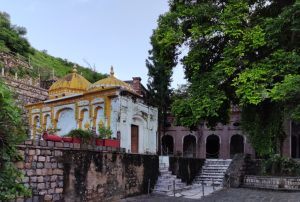
Hiran Minar, Mughal era complex located in Sheikhupura.
October 26, 2021
Takht e Bahi Monastery,Indo-Parthian archaeological site
October 26, 2021
Islamabad, the second most beautiful capital in the world was once home to numerous scattered villages between temples of Golra, Saidpur, and Rawal. Saidpur Village is one of the oldest villages in Pakistan located on the slopes of Margalla Hills in Islamabad.
History
It is an almost 500 years old village known for its legacy, vast history of culture, religious heritage, and influence of three eras of Muslims, Hindu, and Sikhs. Gakhars, Malhairs, and Rajput tribes resided in these villages. Some local Gakhar and Rajput families are still residing in the village.
According to the historic reference, the village was founded by Mirza Fateh Ali in 1530 AD. Initially, the village was known after him as Fatehpur Baoli. However, the name of the village changed from Fatehpur Baoli to Saidpur, when Mughal Emperor Akbar had gifted this area to Said Khan Gakhar for his family’s services in the fight against Sher Shah Suri, an Afghan warrior.
Saidpur was named after Sultan Said Khan son of Sultan Sarang Khan. Sarang Khan was the Raja of the Potohar region during the times of the rule of Mughal Emperor Babur. Later on, Said Khan had given this village to his daughter who had married to Mughal emperor Jahangir. Tusk-e-Jahangiri, a biography of Jahangir mentions him staying in Saidpur while he was on his way to Kabul. It was a greenery enclosure resort with numerous natural streams supplying water for drinking and irrigation.
In 1580, Raja Maan Singh, a Hindu Mughal commander was so in love with the beauty of this village that he turned this village into a place of Hindu worship. He constructed four kunds (ponds) namely Ram Kund, Lakshman Kund, Sita Kund, and Hanuman Kund along with a temple. Saidpur was declared a pilgrim center and those temples have been preserved to show the history and culture of Hindu in the region.
During the 20th century, the Sikh community built a Gurdwara alongside the temple, a big size room attached to the was served as a school for teaching the philosophy of Guru Nanak. Until the Partition, a large number of Hindu gathered and celebrated Baisakhi at Saidpur Village. After partition a large number of Hindus inhabiting the village migrated to India, and so did the brass statues of goddesses Kali and Lakshami. All ponds have vanished away and temples turned into restaurants like Des Pardes and Andaaz.
In 2006, the restoration and preservation by CDA gave a new life to this place. CDA converted the whole village into a multicultural and historical tourist attraction in 2008 that has brought an influx of tourists to this site. The government of France also helped Pakistan by providing technical assistance for the maintenance of the village.
Saidpur is historically fascinating and worth visiting in Islamabad city. It would surely be a lovely experience for tourists to visit the village in the daylight and calm evenings. The Margalla Hills gives it a picturesque view in dim lights mornings and evenings. During the daytime, especially on holidays, the place is packed with people while in the evening; the place narrates its tales of different eras. Both summer and winter have their charm in the village
